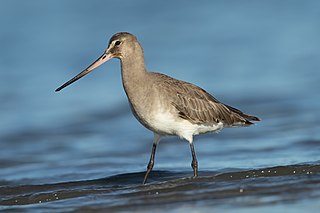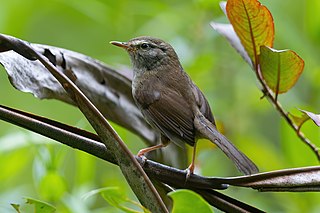
The Hudsonian godwit is a large shorebird in the sandpiper family, Scolopacidae. It is a long distance migratory species that breeds at remote sites in northern Canada and winters in southern South America. The genus name Limosa is from Latin and means "muddy", from limus, "mud". The specific haemastica is from Ancient Greek and means "bloody".The English term "godwit" is believed to imitate the bird's call.

The besra, also called the besra sparrowhawk, is a bird of prey in the family Accipitridae. It was formerly placed in the genus Accipiter. The name "besra" is from the Hindi word for the species.

The sirkeer malkoha or sirkeer cuckoo, is a non-parasitic cuckoo found in dry scrub forest and open woodland habitats in the Indian subcontinent. The species is long-tailed, largely olive brown on the upper side with a distinctive curved red beak tipped in yellow. They forage singly or in pairs mainly on or close to the ground creeping between grasses and bushes, often on rocky habitats where they feed on small lizards, insects, and sometimes berries and seeds. They are very silent and the sexes are identical in plumage.

The aberrant bush warbler is a species in the bush warbler family, Cettiidae. It was formerly included in the "Old World warbler" assemblage.

Phaenicophaeus is a genus of seven species of cuckoos in the family Cuculidae that are found in South and Southeast Asia.

The fawn-breasted waxbill is a common species of estrildid finch found in central Africa. It has an estimated global extent of occurrence of 1,800,000 km2. Estrilda paludicola, E. ochrogaster and E. poliopareia have been lumped into E. paludicola.

The chestnut-naped spurfowl is a species of bird in the pheasant family Phasianidae. At 33–37 cm (13–15 in) in length and weighing 550–1,200 g (19–42 oz), it is a large species of spurfowl. It is found in Ethiopia and Somaliland. The population is believed to be stable but according to the International Union for Conservation of Nature (IUCN) there is insufficient data to make an estimate of the population.

The Fly River grassbird is a species of Old World warbler in the family Locustellidae. It is found in Indonesia and Papua New Guinea. Its natural habitats are freshwater marshes and lakes. It is threatened by habitat loss.

The red-thighed sparrowhawk, alternatively known as the red-legged sparrowhawk or western little sparrowhawk, is a species of sparrowhawk in the family Accipitridae from western and northern central Africa. This species was formerly placed in the genus Accipiter.

The black-mantled goshawk is a species of bird of prey in the family Accipitridae. It is found in the highlands of New Guinea. Its natural habitat is subtropical or tropical moist lowland forests. This species was formerly placed in the genus Accipiter.

The chestnut-bellied cuckoo is a species of bird in the tribe Phaenicophaeini, subfamily Cuculinae of the cuckoo family Cuculidae. It is endemic to Jamaica.

The chestnut-breasted malkoha is a species of cuckoo in the family Cuculidae. Found in Southeast Asia from Myanmar through to eastern Java, the Philippines and Borneo, it is a large cuckoo measuring up to 49 cm (19 in) with grey and dark green upperparts and chestnut underparts, and a large curved pale upper mandible. The male and female are similar in plumage. Unlike many cuckoos, it builds its nest and raises its own young.

The red-billed malkoha is a species of cuckoo in the family Cuculidae. It is found in Brunei, Indonesia, Malaysia, Myanmar, and Thailand. Its natural habitat is subtropical or tropical dry forests.

The chestnut-bellied malkoha is a species of cuckoo in the family Cuculidae. It is found in Brunei, Indonesia, Malaysia, Myanmar, Singapore, and Thailand. Its natural habitats are subtropical or tropical moist lowland forest, subtropical or tropical mangrove forest, and subtropical or tropical swampland. It is threatened by habitat loss.

The Papuan mountain pigeon is a species of bird in the pigeon family, Columbidae. It is found in the Bacan Islands, New Guinea, the D'Entrecasteaux Islands, and the Bismarck Archipelago, where it inhabits primary forest, montane forest, and lowlands. It is a medium-sized species of pigeon, being 33–36 cm (13–14 in) long and weighing 259 g (9.1 oz) on average. Adult males have slate-grey upperparts, chestnut-maroon throats and bellies, whitish breasts, and a pale grey terminal tail band. The lores and orbital region are bright red. Females are similar, but have grayish breasts and grey edges to the throat feathers.

Mountain pigeons are four species of birds in the genus Gymnophaps in the pigeon family Columbidae. They are found on islands in eastern Indonesia and Melanesia, where they inhabit hill and montane forest. Medium-sized pigeons with long tails and wings, they are 33–38.5 cm (13.0–15.2 in) long and weigh 259–385 g (9.1–13.6 oz). They mostly have dull grey, white, or chestnut-brown plumage, their most distinctive feature being bright red skin around the eyes. Males and females mostly look alike, but the Papuan and pale mountain pigeons show slight sexual dimorphism. Mountain pigeons are very social and are usually seen in flocks of 10–40 birds, although some species can form flocks of more than 100 individuals. They are generally quiet and do not make many vocalisations apart from a distinctive whooshing noise while leaving their high-altitude roosts to feed in the morning.

The pied cuckoo-dove is a species of bird in the pigeon family, Columbidae. First described by English zoologist Philip Sclater in 1877, it is endemic to the Bismarck Archipelago, where it mainly inhabits lowland and hill forests at elevations of up to 1,000 m (3,300 ft). It is a large, distinctive pigeon, with a length of 40–46 cm (16–18 in) and a weight of 279–325 g (9.8–11.5 oz). Adults are mainly black and white. The heads and underparts are whitish, while the wings, tails, and upperparts are black. Both sexes look alike. Juveniles are mainly sooty-grey in colour.

The crested cuckoo-dove is a species of bird in the pigeon family, Columbidae. First described by English zoologist John Gould in 1856, it is endemic to the Solomon Islands archipelago, where it mainly inhabits hill forests at elevations of 500–900 m (1,600–3,000 ft). It is a large and robust pigeon, with a length of 40–42 cm (16–17 in) and a distinctive pale purplish-grey crest. Adults are mainly bluish-grey, with a pale greyish-buff throat, blackish tail, and yellow-tipped reddish bill. Both sexes look alike. Juveniles lack the crest, have darker heads, and have duller wings.

The mountain kingfisher is a species of bird in the subfamily Halcyoninae in the family Alcedinidae. Adult males are 21–24 cm (8.3–9.4 in) long, and have a rufous head and underparts, greenish-blue upperparts, a dark blue tail, and black flight feathers. They also have dark neck patches and loral patches. Females have dark crowns and the neck patches join at the nape. It is similar to the yellow-billed kingfisher, but can be distinguished by its larger size and a proportionally larger bill, along with a dark ridge along its culmen.
The pink-breasted flowerpecker is a species of bird in the family Dicaeidae that is native to the south and southeast Maluku Islands of Indonesia. It was formerly considered a subspecies of the mistletoebird.

















